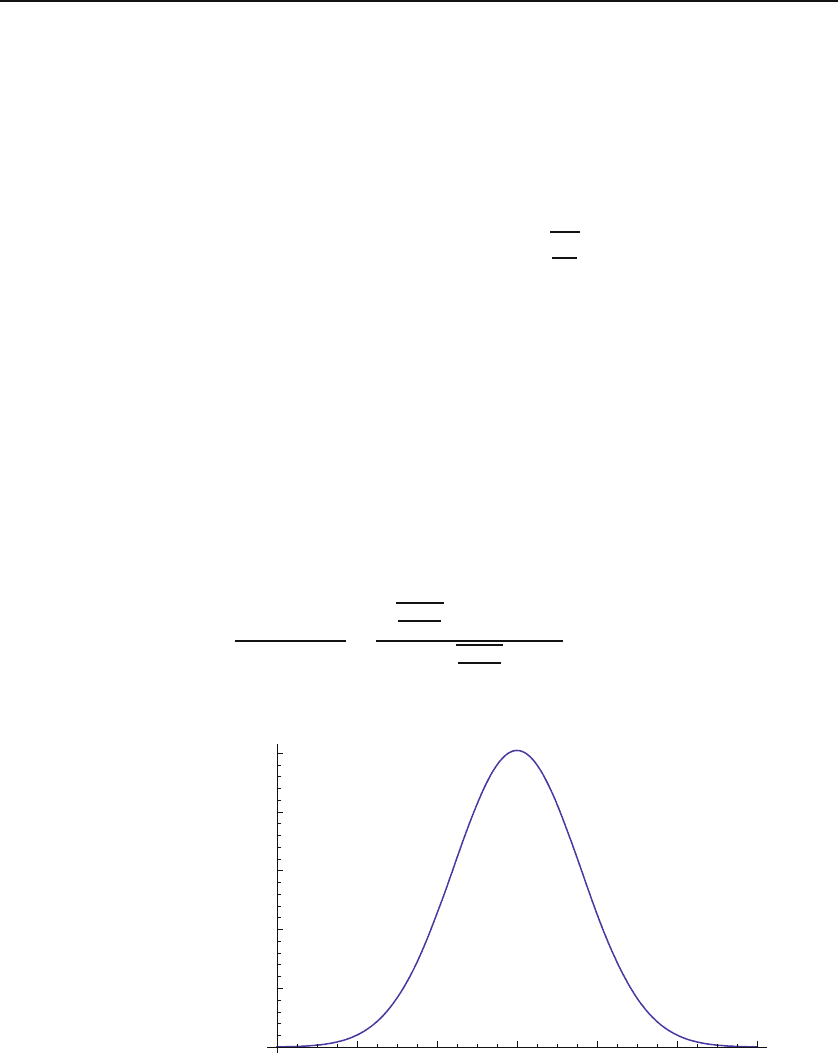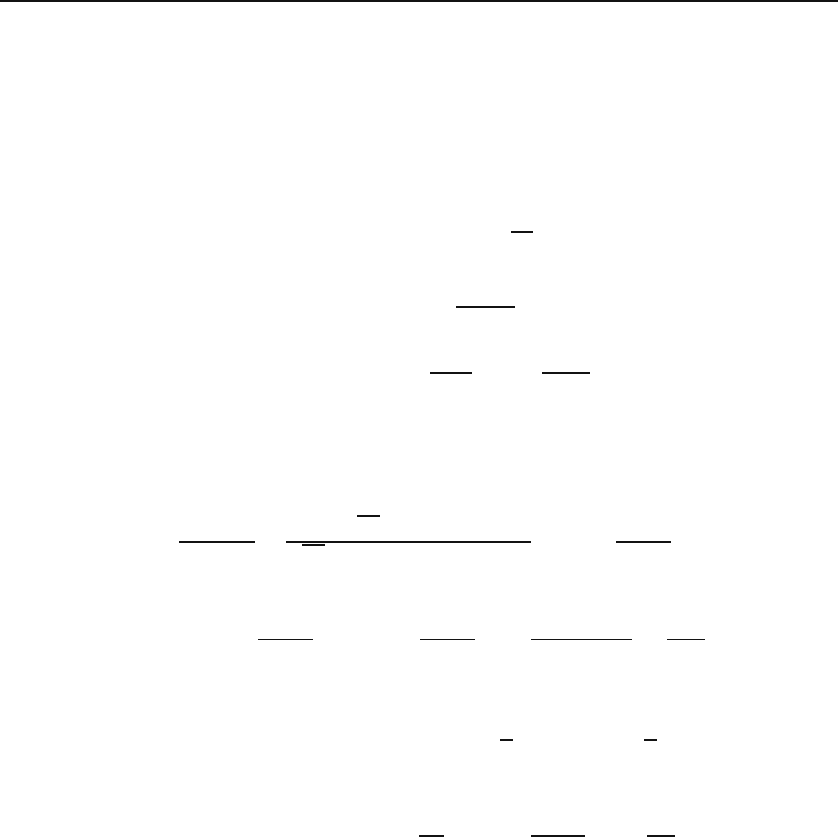Hassani S. Mathematical Methods: For Students of Physics and Related Fields
Подождите немного. Документ загружается.


32.2 Binomial Probability Distribution 793
The special case of p = q =
1
2
is of importance:
P (m, n)=
n!
m!(n − m)!2
n
≈
2
nπ
e
−(n−2m)
2
/2n
. (32.29)
Sometimes (32.28) is written in terms of the difference s between the number
of successes and failures. This is conveniently equal to 2m − n which is the
exponent of the exponential. We call s the success excess. Thus, (32.28)
becomes
P (s, n) ≈
2
nπ
e
−s
2
/2n
, Ω
b
(s, n)=2
n
P (s, n)=2
n
2
nπ
e
−s
2
/2n
,
(32.30)
where Ω
b
is the number of configurations now written in terms of s.
For the binomial distribution we can easily find the moment generating
function. From its definition, we have
e
tX
=
n
x=0
e
tx
P (x, n)=
n
x=0
e
tx
n
x
p
x
q
n−x
=
n
x=0
n
x
(pe
t
)
x
q
n−x
=(pe
t
+ q)
n
, (32.31)
the last equality following from the binomial theorem. Equation (32.31) allows
us to easily calculate the average and variance for the binomial distribution.
First note that
d
dt
e
tX
= npe
t
(pe
t
+ q)
n−1
,
d
2
dt
2
e
tX
= npe
t
(q + npe
t
)(pe
t
+ q)
n−2
.
Now evaluate these at t = 0—and note that p + q =1—toobtain
X = np, X
2
= n
2
p
2
+ npq, σ
2
= X
2
−X
2
= npq. (32.32)
Example 32.2.1.
Assume that the probability at birth that the newborn is male
(or female) is
1
2
. What is the probability that in a household of six, three are male?
Blind intuition tells us that the probability is
1
2
; but that is wrong! Rephrasing the
question to “What is the probability that in six trials we get three successes?” leads
us to the binomial distribution and the following answer:
P (3, 6) =
6!
3!3!
1
2
3
1
2
6−3
=
6!
3!3!
1
2
6
=0.3125.
This result may be surprising, but even more surprising is the result we obtain
if we ask the same question about a (small) school: “What is the probability that
in a school with 200 pupils, 100 are male?”
P (100, 200) =
200!
100!100!
1
2
100
1
2
200−100
=
200!
100!100!
1
2
200
=0.056.

794 Probability Theory
The surprise encountered in the preceding example is due to the confusion
caused by mixing the expected value with its probability. In a binomial distri-
bution, the expected value (or the mean or average) X = np,orX = n/2
when p =0.5, which is the answer we intuitively gave to the two questions in
the example above. Since our surprise increases with n, let us investigate the
behavior of the binomial distribution for values of m close to the mean for
very large n.
For large n and m, we can use (32.29), from which we obtain
P (n/2,n) ≈
2
nπ
.
This shows that P (n/2,n) → 0asn →∞. Thus the probability of having
n/2 successes in n trials becomes negligible as the number of trials increases.
But this is the maximum probability! Therefore, any other probability goes
to zero even faster. Where have all the probabilities gone?
Consider the graph of (32.29) for large n and plot it to a scale such that
the peak of the maximum, although small, is conspicuous. Figure 32.3 shows
such a graph for n = 1000. Note that the maximum probability has a value of
only 0.025, and that the graph drops to a value that is indistinguishable from
zero at about m = 560 on the right and m = 440 on the left. We can actually
calculate the ratio r of the small probability at m = 560 to the maximum at
m = 500 using (32.29):
r ≡
P (560, 1000)
P (500, 1000)
=
2
1000π
e
−(−120)
2
/2000
2
1000π
= e
−(−120)
2
/2000
=0.00075.
460 480 500 520 540 560
0.005
0.010
0.015
0.020
0.025
Figure 32.3: The plot of the binomial probability distribution for n = 1000.

32.2 Binomial Probability Distribution 795
This same ratio is obtained if we use m = 440, and we can therefore conclude
that the nonzero probabilities are essentially concentrated between m
−
= 440
and m
+
= 560 for n = 1000.
Now let’s turn to a general n and find the corresponding values of m
−
and
m
+
. These are the values of m at which the probability drops to 0.00075 of
its maximum value. To find m
±
,wehavetosolvetheequation
r ≡
P (m, n)
P (n/2,n)
=
2
nπ
e
−(n−2m)
2
/2n
2
nπ
= e
−(n−2m)
2
/2n
=0.00075.
The answer is
m
±
=
1
2
(n ±3.8
√
n), (32.33)
as the reader may verify. So for a general n, a large fraction of the total
probability is concentrated between
1
2
(n − 3.8
√
n)and
1
2
(n +3.8
√
n). But
how much? What is the probability that the number of successes lies between
m
−
and m
+
?
To answer this question, we have to add all probabilities between m
−
and
m
+
. For large numbers, one can replace the sum with an integral:
P (m
−
≤ m ≤ m
+
,n)=
#
m
+
m
−
2
nπ
e
−(n−2m)
2
/2n
dm.
Define a new variable of integration x so that the exponent of the integrand
becomes −x
2
. This means
n − 2m
√
2n
= x, or m =
n −
√
2nx
2
,dm= −
√
2n
2
dx,
and the integral in terms of x becomes
1
√
π
#
3.8/
√
2
−3.8/
√
2
e
−x
2
dx =0.999855,
with the last result obtained by numerical integration. Therefore,
P (m
−
≤ m ≤ m
+
,n)=0.999855, (32.34)
which is interestingly independent of n.
Let us investigate the meaning of this result. It says that for very large n,
99.99% of the time the successes lie between m
−
and m
+
, and the probability
of not getting a success between m
−
and m
+
is only 0.0145%. Note also
that when n gets large, m
−
and m
+
become very nearly equal to n/2. For
example, if n =10
9
,then
n
2
=5×10
8
and m
+
=
1
2
(10
9
+3.8
√
10
9
)=5.001 ×10
8
.

796 Probability Theory
So the probabilities are concentrated in a very narrow interval; i.e., the prob-
ability curve is extremely sharp.
Going back to the probability of the male gender, we note that in a very
populous country such as China or India with approximately 10
9
inhabitants,
although the probability that exactly half the population is male is extremely
small, and of the order of
2
nπ
=
2
10
9
π
=0.000025,
the probability of the male population deviating too far from half is also
small. So although the exact success (half male) is highly unlikely, a number
of successes very close to exact is almost certain.
Example 32.2.2.
An isolated spin-
1
2
particle has equal probability of being in
either spin-up or spin-down states. If there are n such particles, then the probability
of m of them being in the up state is given by (32.29) or (32.30).
When a spin-
1
2
particle with magnetic moment μ is placed in a magnetic field
B, it has two possible states: in the direction of the field (called up)andopposite
to it (called down). In the first case the energy of the particle is −μB andinthe
second case +μB. The energy of the system is therefore determined by the success
excess s, which in the present context is called the spin excess.
Now suppose that you have two systems that can exchange energy between
themselves with the combined system isolated. This means that the total energy
of the system is conserved. This energy is determined by the total spin excess s.
Let Ω
1b
(s
1
,n
1
) be the configuration number of the first system and Ω
2b
(s
2
,n
2
)for
the second. Let Ω
b
(s, n) be the number of configurations for the combined system,
where n = n
1
+ n
2
and s = s
1
+ s
2
is a constant. Since the total configuration
number is the product of the configuration number of the components, we have
Ω
b
(s, n)=Ω
1b
(s
1
,n
1
)Ω
2b
(s − s
1
,n
2
)=C exp
−
s
2
1
2n
1
−
(s − s
1
)
2
2n
2
, (32.35)
where C is independent of s
1
.
What is the equilibrium state of the system? This corresponds to the most prob-
able state of the combined system, i.e., the state that maximizes Ω
b
(s, n). Instead
of maximizing Ω
b
, let’s maximize its logarithm, which is
ln Ω
b
=lnC −
s
2
1
2n
1
−
(s − s
1
)
2
2n
2
.
Differentiating with respect to s
1
,weget
∂ ln Ω
b
∂s
1
= −
s
1
n
1
+
s − s
1
n
2
. (32.36)
Note that the second derivative is
−
1
n
1
+
1
n
2
,

32.3 Poisson Distribution 797
which is negative, so the extremum is a maximum. Setting (32.36) equal to zero
yields the most probable configuration: Condition for
thermal
equilibrium
ˆs
1
n
1
=
s − ˆs
1
n
2
=
ˆs
2
n
2
=
s
n
,
where the last equality follows from the previous ones (see Problem 32.13) and a
caret on a quantity indicates its value at maximum. If we substitute these in (32.35),
we get the maximum number of configurations:
Ω
max
b
(s, n)=C exp
−
ˆs
2
1
2n
1
−
ˆs
2
2
2n
2
= Ce
−s
2
/2n
. (32.37)
The verification of the last equality is the subject of Problem 32.14.
Once in equilibrium, how likely is it for the system to move away from it? To
investigate this, let s
1
and s
2
be slightly different from their equilibrium values
s
1
=ˆs
1
+ δ, s
2
= s − s
1
= s − ˆs
1
− δ =ˆs
2
− δ.
Substituting these in (32.35) yields
C exp
−
ˆs
2
1
+2ˆs
1
δ + δ
2
2n
1
−
ˆs
2
2
− 2ˆs
2
δ + δ
2
2n
2
=Ω
max
b
(s, n)exp
−
2ˆs
1
δ + δ
2
2n
1
+
2ˆs
2
δ − δ
2
2n
2
.
But ˆs
1
/n
1
=ˆs
2
/n
2
. Therefore,
Ω
1b
(ˆs
1
+ δ, n
1
)Ω
2b
(ˆs
2
− δ, n
2
)
Ω
max
b
(s, n)
=exp
−
δ
2
2n
1
−
δ
2
2n
2
. (32.38)
As a realistic numerical example, let n
1
= n
2
=10
23
and δ =10
13
so that the
fractional deviation δ/n
1
=10
−10
, a very small number. Then, the ratio in (32.38)
is e
−1000
=5× 10
−435
. The probability for fractional deviations larger that 10
−10
is smaller than e
−1000
. Assuming equal probability and adding the terms (about n
1
How likely is it for
the system to
abandon its
equilibrium state?
of them), the upper bound for the total probability becomes n
1
e
−1000
or 5 ×10
−412
times the probability of finding the system in equilibrium.
What is the meaning behind the statement “the probability to find the sys-
tem with a fractional deviation larger than 10
−10
is 5 × 10
−412
of the probabil-
ity of finding the system in equilibrium?” To have a reasonable chance of finding
the system in such a deviated state, we have to sample 5 × 10
412
similar systems.
Even if we could sample at the rate of 10
12
systems per second, we would have
to sample for 5 × 10
400
seconds,orover10
393
years, or 10
383
times the age of the
universe! Therefore, it is safe to say that deviations described above will never be
observed.
32.3 Poisson Distribution
Poisson processes are famous results in the probability theory. A Poisson
process occurs in circumstances under which an event is repeated at a constant
rate of probability. Suppose that dt is so small that the probability of the
occurrence of two or more successes is negligible. Then the probability P
1
(dt)
of one success in dt is νdt,whereν is a constant.

798 Probability Theory
We are interested in P
n
(t), the probability of n successes in a time interval
t. We can obtain a recursive differential equation involving P
n
(t)andP
n−1
(t),
which we hope to solve to get P
n
(t). Consider P
n
(t + dt), the probability that
n successes occur in time t+dt. This can be written as the sum of two disjoint
probabilities, each consisting of the product of two independent probabilities:
(a) n successes occur in time t and none in time dt,(b)n −1 successes occur
in time t and one in time dt.Insymbols,
P
n
(t + dt)=P
n
(t)P
0
(dt)+P
n−1
(t)P
1
(dt).
But P
1
(dt)=νdt and P
0
(dt)=1−P
1
(dt)=1−νdt. Therefore,
P
n
(t + dt)=P
n
(t)(1 −νdt)+P
n−1
(t)νdt.
Expanding the left-hand side as P
n
(t + dt)=P
n
(t)+
dP
n
dt
dt and dividing
both sides by dt, we obtain the desired recursive DE:
dP
n
(t)
dt
+ νP
n
(t)=νP
n−1
(t). (32.39)
For n =0theright-handsideiszeroandtheDE
dP
0
(t)
dt
+ νP
0
(t)=0
has the solution P
0
(t)=Ae
−νt
. The fact that the probability of no success
in zero time interval is 1 yields A =1.
Equation (32.39) is a first order DE which can be solved. In fact, the
solution is given in Theorem 23.3.1, where in the case at hand
μ(t)=exp
#
νdt
= e
νt
and
P
n
(t)=
1
e
νt
C + ν
#
t
0
e
νt
1
P
n−1
(t
1
) dt
1
.
We must have P
n
(0) = 0 because there is no chance that n successes can
be achieved in zero time interval. This sets C = 0, and we get the integral
recursion relation:
P
n
(t)=νe
−νt
#
t
0
e
νt
1
P
n−1
(t
1
) dt
1
. (32.40)
Substitute for P
n−1
(t
1
)asanintegralofP
n−2
to get
P
n
(t)=νe
−νt
#
t
0
e
νt
1
(
νe
−νt
1
#
t
1
0
e
νt
2
P
n−2
(t
2
) dt
2
)
dt
1
,
or
P
n
(t)=ν
2
e
−νt
#
t
0
#
t
1
0
e
νt
2
P
n−2
(t
2
) dt
2
dt
1
.

32.3 Poisson Distribution 799
It should now be clear that if we repeat this k times, we get
P
n
(t)=ν
k
e
−νt
#
t
0
#
t
1
0
···
#
t
k−2
0
#
t
k−1
0
e
νt
k
P
n−k
(t
k
) dt
k
dt
k−1
··· dt
1
.
In particular when k = n,
P
n
(t)=ν
n
e
−νt
#
t
0
#
t
1
0
···
#
t
n−2
0
#
t
n−1
0
e
νt
n
P
0
(t
n
) dt
n
dt
n−1
··· dt
1
.
But P
0
(t)=e
−νt
so P
0
(t
n
)=e
−νt
n
, and the above equation becomes
P
n
(t)=ν
n
e
−νt
#
t
0
#
t
1
0
···
#
t
n−2
0
#
t
n−1
0
dt
n
dt
n−1
··· dt
1
. (32.41)
Starting with the innermost integral over t
n
and integrating all the t’s, the
reader can show that the result will be t
n
/n!. We thus finally obtain the
Poisson process
P
n
(t)=
(νt)
n
n!
e
−νt
. (32.42)
Poisson process is naturally a time-dependnent process and ν is the rate or
the frequency of that process.
The discrete Poisson distribution p(n) is defined by setting νt = λ to
obtain
Poisson probability
distribution
p(n)=
λ
n
n!
e
−λ
,n=0, 1, 2,...,∞. (32.43)
The moment generating function is
e
tX
=
∞
x=0
e
tx
λ
x
x!
e
−λ
= e
−λ
∞
x=0
(λe
t
)
x
x!
= e
λ(e
t
−1)
. (32.44)
This gives
d
dt
e
tX
= λe
t
e
λ(e
t
−1)
,
d
2
dt
2
e
tX
= λe
t
e
λ(e
t
−1)
(λe
t
+1).
Evaluating these at t =0yields
X = λ, X
2
= λ(λ +1),σ
2
= X
2
−X
2
= λ. (32.45)
Example 32.3.1.
A city had 24 major fire accidents in a year. What is the
probability that there will be (a) one major fire next month, (b) at least 5 major
fires in the next 6 months?
Here ν, the frequency of fire is 24 per year or 2 per month. So for (a) we have
λ =2×1=2and
p(1) = λe
−λ
=2e
−2
=0.27.
For (b), λ =2×6 = 12 and
p(n ≥ 5) = 1 −p(0) −p(1) − p(2) − p(3) − p(4)
=1−e
−12
− 12e
−12
−
12
2
2!
e
−12
−
12
3
3!
e
−12
−
12
4
4!
e
−12
=0.992.

800 Probability Theory
Example 32.3.2. In a department store, 39 light bulbs burn out per year. The
light bulbs are replaced from the store stock, which is replenished every week. What
is the minimum number of light bulbs the stock should hold so that the store will
have all its light bulbs working with a probability of at least 99%?
The frequency is ν =39/52 = 0.75 per week. Thus, λ =0.75 × 1=0.75. Let
n stand for the number of bulbs burnt per week and m the number of bulbs in the
stock. Then the store will have all its lights on as long as n ≤ m. Therefore, we
want p(n ≤ m) ≥ 0.99. This gives
p(n ≤ m)=
m
n=0
λ
n
n!
e
−λ
≥ 0.99,
or
p(n ≤ m)=
m
n=0
(0.75)
n
n!
≥ 0.99e
0.75
=2.096,
or
1+0.75 +
0.75
2
2!
+ ···+
0.75
m
m!
≥ 2.096.
By trial and error, the reader can verify that m =3.
Poisson distribution is the limiting case of the binomial distribution when
n →∞, p → 0, and λ = np is constant. To see this, expand n!/(n −m)! using
the Stirling approximation:
n!
(n −m)!
≈
√
2πe
−n
n
n+1/2
√
2πe
−n+m
(n −m)
n−m+1/2
= e
−m
n
n − m
n+1/2
(n − m)
m
.
Now note that
n
n − m
n+1/2
≈
n
n −m
n
=
1
(1 −m/n)
n
→
1
e
−m
= e
m
,
and (n − m)
m
≈ n
m
.Furthermore,
q
n−m
=(1−p)
n−m
=
1 −
λ
n
n−m
≈
1 −
λ
n
n
→ e
−λ
.
Substituting all this in (32.27) yields
P (m, n) → n
m
1
m!
p
m
e
−λ
=
(np)
m
m!
e
−λ
=
λ
m
m!
e
−λ
,
which is the Poisson distribution p(m).
Example 32.3.3.
A 3000-letter long message has been transmitted electronically
with an error probability of 10
−3
. What is the probability that there are at least
two errors in the message?
This is a binomial distribution (error is success!) with small probability and large
n. Therefore, we can use Poisson distribution (32.43) with λ = np = 3000×10
−3
=3.
Then
p(n ≥ 2) = 1 − p(0) − p(1) = 1 − e
−3
− 3e
−3
=0.8.
The probability that there is exactly one error in the message is
p(1) = 3e
−3
=0.149.

32.4 Continuous Random Variable 801
32.4 Continuous Random Variable
Most probability sample spaces are so large that approximating the discrete
events with continuous variables becomes very useful and accurate. Take the
case of the binomial distribution discussed above. We started with discrete
counting, but when our sample grows to 10
23
, not only does the discrete sum
become unmanageable, it becomes unnecessary as well. This is also reflected
in the replacement of the strictly discrete factorial with the more adaptable
exponential function through the use of the Stirling approximation.
When continuous variables are used, probability is described by proba-
bility density. In the case of a single random variable x, the probability
Probability density
density f (x) is used to give the probability that x lies in an interval of length
dx:
P (x − dx/2 <x<x+ dx/2) = f(x) dx,
#
b
a
f(x) dx =1,
where (a, b) is the interval for which x is defined. This interval can be taken
to be (−∞, ∞) by assigning zero probability density to points on the left of
a and on the right of b. The integral describes the total probability, which is
1 as in the case of the discrete variable.
For more variables, the generalization is clear. If x =(x
1
,x
2
,...x
m
)and
the probability density function is f (x), then the probability that x is in an
infinitesimal m-dimensional volume d
m
x is
P (x ∈ d
m
x)=f(x) d
m
x,
##
Ω
f(x) d
m
x =1, (32.46)
where Ω is the region for which f(x) is defined. If V is a subset of Ω, then
P (x ∈ V )=
##
V
f(x) d
m
x
gives the probability that x lies in V .
For example, a quantum mechanical wave function Ψ(r)givesrisetoa
density f(r)=|Ψ(r)|
2
, and all wave functions are normalized so that
##
Ω
|Ψ(r)|
2
d
3
x =1 and P (r ∈ V )=
##
V
|Ψ(r)|
2
d
3
x, (32.47)
where r is a set of convenient coordinates.
The average and variance is defined in exactly the same way. For example,
the average of the ith component of x, denoted by X
i
,isgivenby
X
i
=
##
Ω
x
i
f(x) d
m
x. (32.48)
Similarly
σ
2
(X
i
)=
##
Ω
(x
i
−X
i
)
2
f(x) d
m
x, (32.49)

802 Probability Theory
and
g(X) =
##
Ω
g(x)f(x) d
m
x. (32.50)
Example 32.4.1.
The ground state of the hydrogen atom is described in spherical
coordinates by the wave function Ae
−r/a
0
,wherea
0
is the Bohr radius, A is a
constant to be determined by the normalization (32.47), and r is the distance of the
electron to the nucleus, which is placed at the origin. Using the volume element in
spherical coordinates, we have
1=A
2
#
∞
0
#
π
0
#
2π
0
e
−2r/a
0
r
2
sin θdrdθdϕ=4πA
2
#
∞
0
e
−2r/a
0
r
2
dr
a
3
0
/4
= πA
2
a
3
0
,
giving A =
1/πa
3
0
.Thusthenormalized wave function for the ground state of the
hydrogen atom is
Ψ(r, θ, ϕ)=
"
1
πa
3
0
e
−r/a
0
,
with |Ψ(r, θ, ϕ)|
2
being the probability density of finding the electron at (r, θ, ϕ).
From this, we can calculate, for instance, the probability that the electron ap-
proaches the nucleus to within 10% of the Bohr radius. The second equation in
(32.47) gives the answer where V is the volume of a sphere with radius 0.1a
0
.
Therefore,
P (r ∈ V )=
1
πa
3
0
#
0.1a
0
0
#
π
0
#
2π
0
e
−2r/a
0
r
2
sin θdr dθ dϕ
=
4
a
3
0
#
0.1a
0
0
e
−2r/a
0
r
2
dr =
1
2
#
0.2
0
e
−x
x
2
dx ≈ 0.0013,
where we used the change of variables r = a
0
x/2 in the last integral to turn it into
a numerical factor.
We can also calculate some averages. For instance, the average for the x coor-
dinate of the electron is (remember that x = r sin θ cos ϕ)
X =
1
πa
3
0
#
∞
0
#
π
0
#
2π
0
r sin θ cos ϕe
−2r/a
0
r
2
sin θdr dθ dϕ =0.
The result of zero being due to the ϕ integration. Similarly, Y and Z also vanish.
This null result should be expected because it is just as likely for the electron to
have a positive x value as it is to have a negative value. On the other hand, r is
always positive, and we expect its average value to be nonzero. In fact,
R =
1
πa
3
0
#
∞
0
#
π
0
#
2π
0
re
−2r/a
0
r
2
sin θdr dθ dϕ =
4
a
3
0
#
∞
0
e
−2r/a
0
r
3
dr
=3a
4
0
/8
=
3
2
a
0
.
A random variable x
α
is said to be independent of the rest of the variablesIndependent
random variable
if the probability density f(x) factors out into
f(x)=g(x
α
)h(x
1
,x
2
,...,x
α−1
,x
α+1
,...,x
m
) ≡ g(x
α
)h
α
(x),
